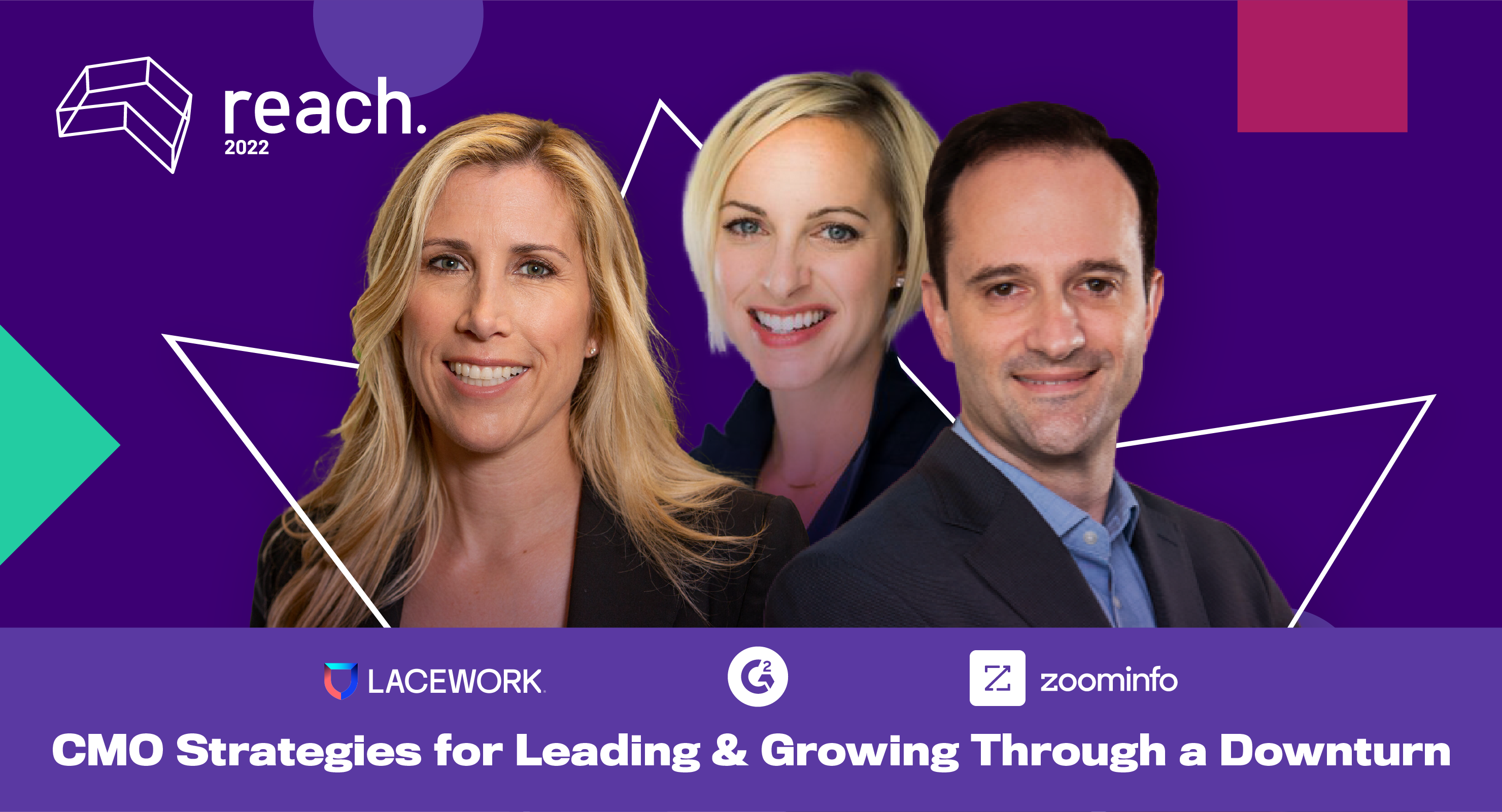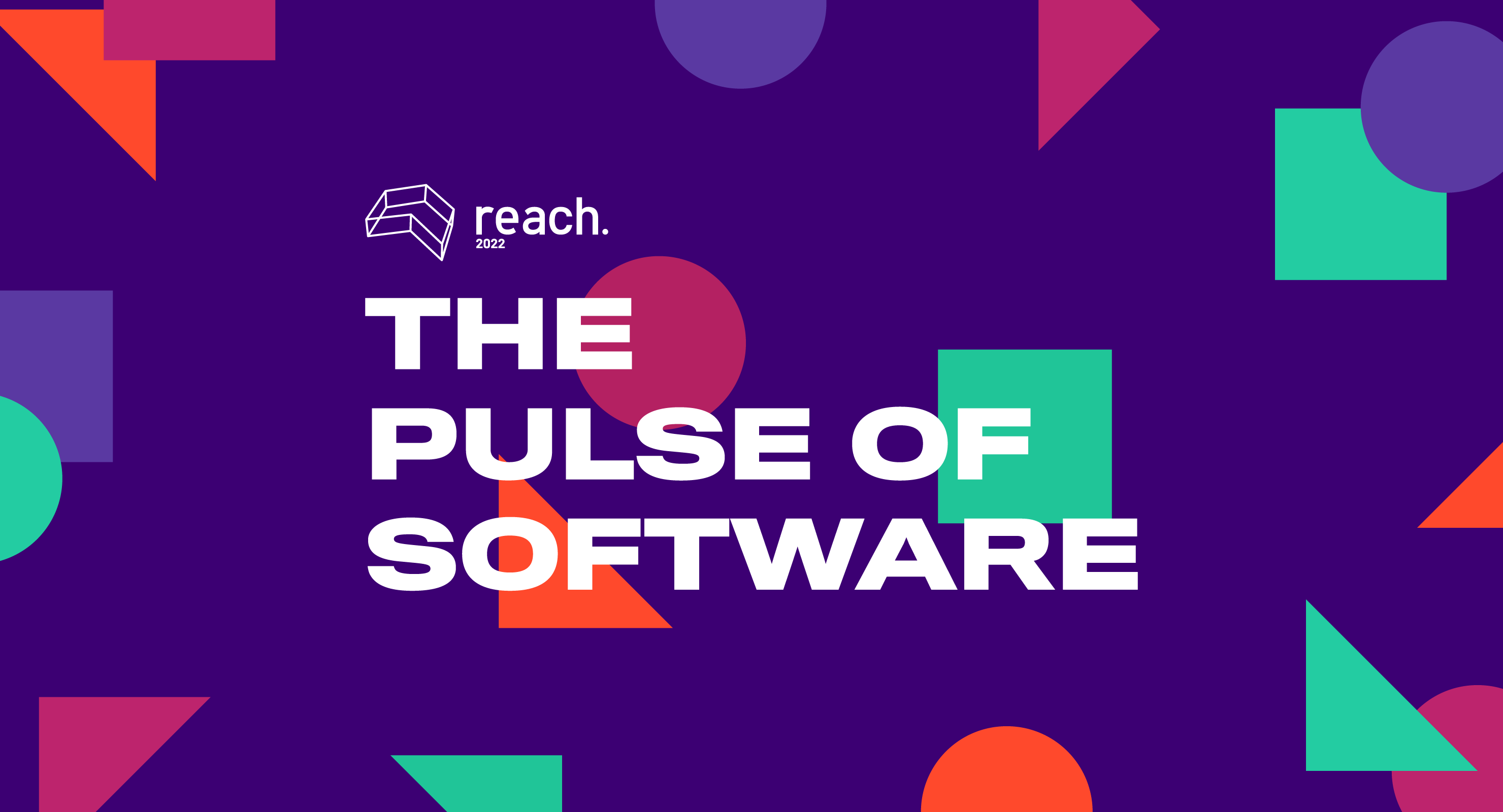
December 8, 2022
.jpg?width=400&height=150&name=G2Headshots_Aayushi_Sanghavi_ZOE1415-Edit%20(1).jpg) by Aayushi Sanghavi
by Aayushi Sanghavi

You can either drown or rise above to ride the waves.
Leading through economic downturns is scary and can cause panic across all departments, especially the overarching marketing divisions. Even though marketing is the core of every business project and product launch, it’s also prone to having the most budget cuts during rough times as companies adjust their business plans and expenses.
Our CMO, Amanda Malko, sat with top marketing leaders in the SaaS space to understand how their teams cope with the current economic downturn during our immersive virtual conference, G2 Reach. The panel included Bryan Law, CMO at ZoomInfo, and Meagen Eisenberg, CMO at Lacework - both leaders in their respective software categories on G2.
The conversation with our panelists began by discussing the similarities between business shutdowns during the pandemic and the current economic environment. Everyone agreed that though the two scenarios are vastly different concerning the extent of abruption, forecast time, and business impact, both exemplify massive shifts in organizational and customer priorities.
Eisenberg dove into the harsh truths by referencing her time at TripActions and how the company’s revenue dropped by 90% during the lockdowns as people traveled less. The business had to pivot quickly to focus on its core: employees and existing customers.
She elucidates that during times of chaos, the teams referred back to trusted information sources – in this context, the Center For Disease Control and Prevention (CDC) – to alleviate people’s fear.
A few words from @Lacework CMO, Meagen Eisenberg, on leading & growing through a downturn👏. If you missed the session, don’t worry! Watch later on-demand - recording coming soon. #G2Reach22 pic.twitter.com/c45ekTIwC3
— G2 (@G2dotcom) December 1, 2022
Law took a walk down a contrasting memory lane while talking about his stint at Tableau and shared that the uncertain times during COVID-19 proved beneficial for the business. The company experienced a 20-30% increase in traffic, which they could capitalize on and sustain in the long run.
ZoomInfo’s leader highlighted his then team's strategy of changing their business tone from selling to focusing on providing accurate data and making the product accessible for everyone to use. This strategy was valuable as it put the company in a unique position to assist non-governmental organizations (NGOs) and government organizations, improving the pipeline drive and positive business impact.
Every marketer asks how they will lead, adapt, and change during a downturn. Our panelists answer the first part of the question with a resounding response: empathy, there’s no other way.
To cope with the changes, the CMOs are aligned that investing in the product is the way to move forward.
Experiment with ideas, cycle them to see if they work, and lead with an adaptive mindset to set teams up for success. This is the golden time to reflect on what parts of the product require tweaking and making those iterative gains in time for the future when things accelerate.
“Don’t panic or lose the plot, and don’t try everything simultaneously. Be thoughtful, invested, and focused on the voice of your customers. Make agile product decisions using robust data to fuel growth.”
Bryan Law
CMO at ZoomInfo
Customers increasingly engage in product research on third-party review sites such as G2. When panic rises, it can be challenging to identify how to get buyers into the purchasing process sooner. The marketing experts agree that to make timely decisions, leaders should use data insights to drive consistent and actionable decisions across departments.
Eisenberg has a simple mantra - you can’t do everything, so look at buyer intent data signals and activity to communicate crisp stories to sales teams on why now matters.
Make ROI your focal point and show how you can lower costs, grow the pipeline, and reduce the time to close deals. Create a sense of urgency for your customers by getting to them first and delivering value.
A strategist at heart, Law focuses heavily on data and reviewing the biggest market opportunities. Consider what you want to narrow down, be it different geographies or life cycles, to align on leadership and ways to win in selected spaces.
List all the areas where you are seeing success and amplify those points to understand which customers align with your goals. Law mentions creating scalable plays across sales and marketing to set up buyer committees, trigger campaigns, and reach relevant audiences.
Malko pitches in and states that balancing your time on customer acquisition versus business expansion is the secret to maximizing resources and effort.
Talking about the present, Law sheds light on how ZoomInfo uses a combination of customer data platforms attached to testing applications to optimize variables based on different systems.
Having thoughtful ideas, moving quickly, deprioritizing on the go, and implementing a data-based testing approach helps marketers get the most out of their automation tools.
Malko shares that leaders must see tests as a way to learn and expect failure, pointing to which areas require testing.
Lacework’s Eisenberg says it is easy to forget that a business’ biggest channel is internal during unpredictable situations. When in doubt, reach out over and over again.
Constantly sync up with your employees and teams for real-time feedback, and check in continually to see who is converting and what factors are helping those transactions. She states that connecting to the field is key for seamless organizational communication.
As unique and unpredictable as downturns can be, deciding when to pivot on existing strategies and looking out for shift indicators can ease feelings of uncertainty.
Eisenberg puts it extremely simply: always look for signals that can help drive revenue and increase business efficiency, especially during tough times. She says that tightening the belt across all organizational levels, from hiring employees and forming partnerships to the C-suite, is key to maintaining alignment and transparency.
An important point brought out by Lacework’s CMO is to plan for optionality, as Malko phrases the mindset. Budgets are tight, and a big focus for everyone is to lower costs - plan for when resource allocations change and have clarity on which ideas should and shouldn’t be prioritized and how these decisions will impact business goals.
Talking about indicators of change, Law states that it is becoming increasingly difficult for marketing campaigns to stand out and break through the noise. He believes listening to customers and internalizing their feedback should set the tone for new messaging.
Tools like social listening, peer review sites, and conversational intelligence platforms are vital channels for understanding how customer needs change and the causes of those shifts. ZoomInfo’s marketing team also conducts regular check-ins with the sales and product departments to ensure alignment right from the first stage of the funnel and product life cycle.
You can’t not talk about software and the evolving market conditions in a SaaS conversation. Malko asks the panelists principal questions regarding the changing buyer behavior. Shedding light on G2’s customer experience, she says third-party review sites are becoming the epicenter of transformational buying.
“85% of enterprises turn to peer review sites, and 60% of those customers have made a product decision even before talking to sales reps.”
Amanda Malko
CMO at G2
The importance of solid value propositions, social proof, and customer reviews in purchase decisions hasn't changed. All experts agree that people do more extensive research before buying software, where software review sites like G2 become integral to the buyer journey.
One of the biggest focuses for Lacework recently has been on the quality of their tech stack per the landscape, cost-effectiveness, and ROI. Eisenberg states that understanding what stack buyers view as “must-haves” is critical to staying relevant and successful.
Eisenberg puts it perfectly: when you know why customers make certain tech choices, you can build sales assets to land more deals and shorten selling cycles.
Although customers are exploring more than ever interacting with companies, Law is confident that buyers still crave the personal touch, which is only possible when sales and marketing are aligned. The seasoned marketer makes two critical points to describe how leaders view both departments in the new landscape:
G2’s CMO summarizes by encouraging leaders to move forward through community-led growth, establish human connections through small and large events, and focus on overall efficiency and improving team enablements.
“In 2023, what are your top three marketing priorities? How, if at all, have those changes in the past few months with the market volatility?”
This question by an audience member sparked a lot of curiosity, and our panelists provided insightful responses.
Law believes that data will be the primary driver of any decisions businesses make, but it should continue beyond data-based decisions. Once there is data alignment, it is essential to double down and start prioritizing (and de-prioritizing) ideas for refined focus on necessary strategies.
That said, the customer’s voice must always remain at the forefront of conversations and campaigns to rein in customer advocacy.
What piqued Malko’s interest is ZoomInfo's focus on enhancing its brand value and increasing product awareness and value. Law states that he wants to dive deep to understand why certain industries and segments are disproportionately converting more than others. This analysis, he says, will help drive growth in the coming year.
Referencing his time at Tableau, ZoomInfo’s CMO recalls how almost 50% of the company’s transactions went through self-service options and how that supplemented sales pipelines.
“People enjoy the flexibility of going between salespeople and self-service.” Facts.
Eisenberg describes a fascinating approach to the question at hand and says that an exercise she likes to do is write down everything that stakeholders say is important to the business and present those ideas back to them. This method, she says, is insightful as priorities change once they are repeated and reviewed.
The magic of this approach is that it can be executed at any level across the organization and effectively reduces feelings of overwhelm and burnout.
“But how do marketers plan for the future when forecasting seems almost impossible?”
Eisenberg answers this question by drawing attention to three things:
Investing in creating a new marketing tone, re-working assets such as websites and sales pitches, and focusing on early-stage product development makes it easier to meet pipeline and customer needs. The current focus for Lacework is working toward making security teams efficient, preventing alert fatigue, and highlighting its value proposition.
Eisenberg’s tips include staying up-to-date with upcoming customer renewals and their estimated targets, strengthening product positioning, and striving to be top of mind for new buyers in the market to enter their product selection set.
It may take some time for the economy to return to a good pace and see positive business impacts. But our SaaS marketing experts see value in having the time to introspect on existing strategies and renew business focus.
Be prepared for changes. Adapt through innovation, start planning for the future with strong product sets and impactful data insights, and grow through empathy.
The experts agree that customers are conducting extensive research on review sites to make purchases. Learn more about the impact of online reviews and how to use them to bolster your marketing strategies.

Get industry-led expert advice on marketing in a down economy to come out strong.
Aayushi Sanghavi is a Campaign Coordinator at G2 for the Content and SEO teams at G2 and is exploring her interests in project management and process optimization. Previously, she has written for the Customer Service and Tech Verticals space. In her free time, she volunteers at animal shelters, dances, or attempts to learn a new language.

Get industry-led expert advice on marketing in a down economy to come out strong.
After an eight week hiatus, #G2Fireside Twitter Chat is back and better than ever.
 by Hannah Tow
by Hannah Tow
Hosting a Twitter chat is an excellent community-building exercise.
 by Sharanya Manola
by Sharanya Manola
How do you feel about meeting new people?
 by Bridget Poetker
by Bridget Poetker
After an eight week hiatus, #G2Fireside Twitter Chat is back and better than ever.
 by Hannah Tow
by Hannah Tow
Hosting a Twitter chat is an excellent community-building exercise.
 by Sharanya Manola
by Sharanya Manola
Never miss a post.
Subscribe to keep your fingers on the tech pulse.


